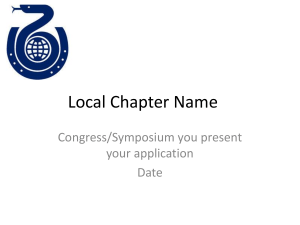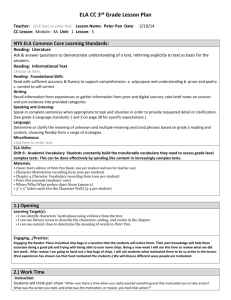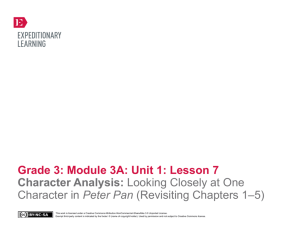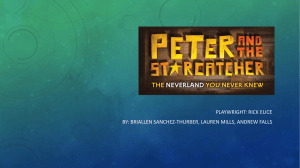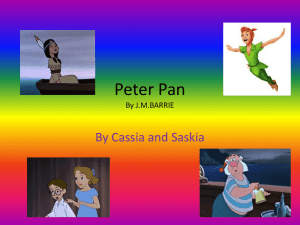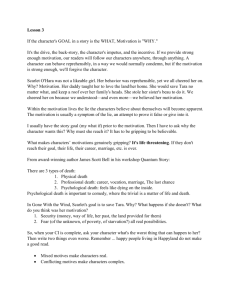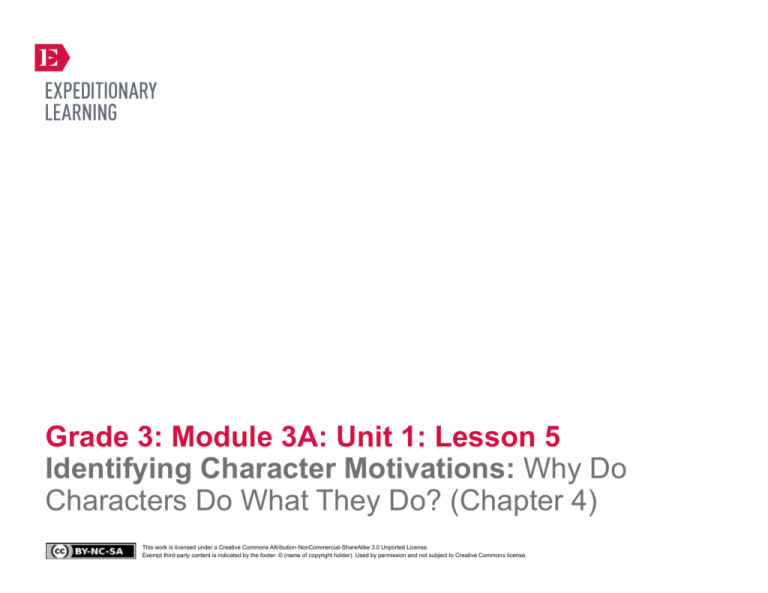
Grade 3: Module 3A: Unit 1: Lesson 5
Identifying Character Motivations: Why Do
Characters Do What They Do? (Chapter 4)
This work is licensed under a Creative Commons Attribution-NonCommercial-ShareAlike 3.0 Unported License.
Exempt third-party content is indicated by the footer: © (name of copyright holder). Used by permission and not subject to Creative Commons license.
GRADE 3: MODULE 3A: UNIT 1: LESSON 5
Identifying Character Motivations:
Why Do Characters Do What They Do? (Chapter 4)
Long-Term Targets Addressed (Based on NYSP12 ELA CCLS)
I can describe the characters in a story (traits, motivations, feelings). (RL.3.3)
I can determine the meaning of words using clues from the story. (RL.3.4)
I can use literary terms to describe parts of a story or poem (e.g., chapter, scene, stanza). (RL.3.5)
Supporting Learning Targets
Ongoing Assessment
• I can identify characters’ motivations using evidence from the text.
• I can use literary terms to describe the characters, setting, and events in the chapter.
• Collecting Words to Describe Character Traits (from
homework)
• I can use context clues to determine the meaning of words in Peter Pan.
• Character Motivations recording form
• Chapter 4 Character Vocabulary recording form
• Where/Who/What recording form (in journal)
Copyright © 2013 by Expeditionary Learning, New York, NY. All Rights Reserved.
NYS Common Core ELA Curriculum • G3:M3A:U1:L5 • June 2014 •
1
GRADE 3: MODULE 3A: UNIT 1: LESSON 5
Identifying Character Motivations:
Why Do Characters Do What They Do? (Chapter 4)
Agenda
Teaching Notes
1. Opening
A. Sharing Character Trait Words (5 minutes)
• This lesson follows a similar pattern to that of Lesson 4, with a new emphasis on characters’
motivations.
B. Unpacking the Learning Targets (5 minutes)
• In advance: Prepare the Character Motivations anchor chart (see example in supporting materials).
2. Work Time
• Review: Think-Pair-Share (Appendix).
A. Mini Lesson: Identifying Character Motivations:
Revisiting Peter and Tinker Bell in Chapter 3 (10
minutes)
B. Read-aloud: Introducing Chapter 4 (5 minutes)
C. Independent Reading: Focus on Characters’
Motivations in Chapter 4 (15 minutes)
D. Small Group Discussion and Chapter 4 Character
Vocabulary Words (15 minutes)
3. Closing and Assessment
A. Where/Who/What Anchor Chart (5 minutes)
4. Homework
A. Reread your favorite page from Chapter 4, either by
yourself, or aloud to someone at home. Focus on an
action that a character took on that page and discuss the
motivation the character had. Why did he or she do
what he or she did?
Copyright © 2013 by Expeditionary Learning, New York, NY. All Rights Reserved.
NYS Common Core ELA Curriculum • G3:M3A:U1:L5 • June 2014 •
2
GRADE 3: MODULE 3A: UNIT 1: LESSON 5
Identifying Character Motivations:
Why Do Characters Do What They Do? (Chapter 4)
Lesson Vocabulary
Materials
character, motivation, evidence;
flattered (27), maternal (28), sly (31)
• Character Motivations anchor chart (new; teacher-created; one for display)
• Classic Starts edition of Peter Pan (book; one per student and one for teacher use)
• Character Motivations recording form (one per student)
• Character Motivations recording form (answers, for teacher reference)
• Chapter 4 Character Vocabulary recording form (one per student)
• Chapter 4 Character Vocabulary recording form (answers, for teacher reference)
• Peter Pan journals (students’ own)
• Where/Who/What anchor chart (from Lesson 2)
• 3" x 5" index cards (for the Character Wall) (3-4 per student)
Meeting Students’ Needs
Opening
A. Sharing Character Trait Words (5 minutes)
• Invite students to bring their Collecting Words to Describe Character Traits homework and sit next to their reading partner
in the whole group area. Allow students a couple of minutes to share with their reading partners, encouraging them to write
down words their partners found if they do not already have it.
B. Unpacking the Learning Targets (5 minutes)
• Direct students’ attention to today’s learning targets. Invite them to read the learning target along with you: “I can identify
character motivations using evidence from the text.”
• Ask students to Think-Pair-Share:
* “What words do you think are most important in today’s learning target? What will we be focusing on as we read, think,
write, and talk?” Listen for students to identify the words character, motivation, and evidence.
Copyright © 2013 by Expeditionary Learning, New York, NY. All Rights Reserved.
• Confusion about the word
motivation can serve as a bridge
into the mini lesson: “I heard some
of us wonder what the word
motivation means. That’s an
excellent question, let’s look more
closely at this word.”
NYS Common Core ELA Curriculum • G3:M3A:U1:L5 • June 2014 •
3
GRADE 3: MODULE 3A: UNIT 1: LESSON 5
Identifying Character Motivations:
Why Do Characters Do What They Do? (Chapter 4)
Work Time
Meeting Students’ Needs
A. Mini Lesson: Identifying Motivations: Revisiting Peter and Tinker Bell in Chapter 3 (10 minutes)
• Like in Lesson 4, make an explicit connection between the learning students did in Module 1 and the deep character study
they are in now. This might sound like: “When we thought about our picture books, we thought about Somebody Wanted.
What were we thinking about when we said ‘wanted’?” Look for shares such as: “We were figuring out the goal of the
character, what it is they wanted in that story.”
• Providing students with a simple
sentence frame can support them in
their thinking as they connect
actions with motivations. “Once I
____________ [action] because I
wanted __________________
[motivation].”
• Direct students’ attention to the Character Motivations anchor chart. Circle the word motivation. Invite students to
share as a whole class what they already know about this word. Guide students toward a definition: “Motivation is what a
person, or a character, wants. It is the reason he or she acts a certain way.” Point out the root motive, which students may
have heard in terms of the motive related to anything from why someone does charity work or commits a crime.
• Tell students that all people have motivations, or reasons they take certain actions. For example, perhaps there was a time
that they really wanted to do something special, like go to the movies, and this motivated them to do their homework quickly
and without complaint. The motivation in this example is the desire to go to the movies.
• Invite students to think about the idea of motivation as it applies to themselves:
* “When was there a time when you really wanted something and that motivated you to take action? What was the action
you took, and what was the motivation, or reason, you took that action?”
• Give students a few seconds of think time, asking them to give a thumbs-up when they have thought of a time when they
wanted something and it made them take a specific action. Invite students to Think-Pair-Share their ideas.
• Remind students of the character trait work they did in Lesson 4, specifically the connection they made to real people in
their lives. Connect that to today’s learning. This may sound like: “Remember that really important work you did with
character traits and how we talk about characters in a book in the same way that we talk about real people in our lives?
Thinking about characters’ motivations in a story is just like thinking about real people. When characters, like people we
know, take specific actions or say specific things, we wonder, ‘What reason did the character have for doing, or saying, that?
What was their motivation?’” Tell students they will be practicing this as they learn more about the characters in Peter Pan.
• Ask students to open their Peter Pan books to page 17. Tell students that they will follow along as you read, and they
should listen for Peter’s motivation to go back to the Darlings’ house. What was his reason?
Copyright © 2013 by Expeditionary Learning, New York, NY. All Rights Reserved.
NYS Common Core ELA Curriculum • G3:M3A:U1:L5 • June 2014 •
4
GRADE 3: MODULE 3A: UNIT 1: LESSON 5
Identifying Character Motivations:
Why Do Characters Do What They Do? (Chapter 4)
Meeting Students’ Needs
Work Time (continued)
• Read aloud page from the bottom of page 17, beginning with “The children’s room …” and ending at the bottom of page 18
(“… and she sat up in bed”). After reading, ask students to Think-Pair-Share:
* “What was Peter’s motivation for returning to the Darlings’ house?”
• Share out whole group. Add Peter’s motivation to the Character Motivations anchor chart.
• Ask students to Think-Pair-Share a second time:
* “What specific evidence on pages 17 and 18 makes you believe that this was his motivation?” Add evidence to the
Character Motivations anchor chart. Listen for shares such as: “On page 18, it says ‘Tink?’ he called softly. ‘Is my shadow
in that jug?’” or “On page 18 it says, ‘Peter threw open the drawers, piling the clothes in a heap on the floor, and found his
shadow.’” Both of these examples show that Peter came back to find his shadow.
B. Read-aloud: Introducing Chapter 4 (5 minutes)
• Ask students to open their Peter Pan books to Chapter 4, page 26. Invite them to read along as you read aloud pages 26 and
27. The purpose of this read-aloud is to engage students and to model fluent reading. Therefore there should be no pauses
for discussion, explanation, or questioning.
Copyright © 2013 by Expeditionary Learning, New York, NY. All Rights Reserved.
• The read-aloud portion of the
chapter serves to build fluency and
hook kids into the chapter.
NYS Common Core ELA Curriculum • G3:M3A:U1:L5 • June 2014 •
5
GRADE 3: MODULE 3A: UNIT 1: LESSON 5
Identifying Character Motivations:
Why Do Characters Do What They Do? (Chapter 4)
Work Time (continued)
Meeting Students’ Needs
C. Independent Reading: Focus on Characters’ Motivations in Chapter 4 (15 minutes)
• Distribute the Character Motivations recording form to students.
• When circulating and supporting
students, invite them to read aloud
an excerpt from wherever they are
at in the text. This will allow you to
assess and coach their fluency.
• Tell students that today they will read Chapter 4 of their Peter Pan books, starting back at the beginning of the chapter.
While reading, they should focus their attention on the actions characters take and the reasons or motivations for why they
take these actions. Tell them they will focus on a few actions, listed in the “Character Action” column of their recording form.
• Give directions:
1.
Sit next to your reading partner.
2.
Read Chapter 4 of your Peter Pan book on your own.
3.
Ask your partner for help if you are confused or stuck.
4.
Focus your attention on the actions the characters take, and why they took those actions. What was their motivation?
Remember to use evidence from the text to supports your ideas.
5.
Complete the Character Motivation recording form for Chapter 4.
D. Small Group Discussion and Chapter 4 Character Vocabulary (15 minutes)
• Combine two partnerships to form groups of four. Remind students of the classroom expectations for discussion before they
begin. Ask students to share the character motivations they identified as well as the evidence they used to support their
thinking. Circulate and support students in their discussion.
• Distribute the Chapter 4 Character Vocabulary recording form to students.
• Remind students that the meaning of these words can be determined by looking at clues in the story around the word.
• Although reading partnerships are
homogeneous, consider forming
groups of four across skill levels in
order to scaffold some students in
their reading, thinking, writing, and
talking.
• Ask students to work on these three words from the chapter with their reading partner.
• After about 5 minutes of work time, allow students to share as a whole class in order to check understanding for all.
• Tell students that each of these words will continue to add to our understanding of characters in the story. It should be
placed with their vocabulary work in their Peter Pan journals.
Copyright © 2013 by Expeditionary Learning, New York, NY. All Rights Reserved.
NYS Common Core ELA Curriculum • G3:M3A:U1:L5 • June 2014 •
6
GRADE 3: MODULE 3A: UNIT 1: LESSON 5
Identifying Character Motivations:
Why Do Characters Do What They Do? (Chapter 4)
Closing and Assessment
Meeting Students’ Needs
A. Where/Who/What Anchor Chart (5 minutes)
• Invite students back to the whole group area. Direct their attention to the Where/Who/What anchor chart. Ask
students to share with the whole class their ideas for the important characters, events, and settings for this chapter.
• Consider adding visual
representations next to the words
on the Character Wall.
• As students share ideas for the “What” column of this anchor chart, think aloud to make a clear connection between what a
character does and his or her motivation for doing it. This will help students to understand the deep thinking they are doing
about characters and their actions. “As I write that Wendy [Who] decided to go to Neverland [What], I am also thinking
about Wendy’s motivation, or why she took that action. She wants to see all the fantastical creatures who live in this place. I
think that would motivate me too! This helps me to better understand Wendy as a character when I think about it this way.”
• Invite students to share any words they would like to add to the Character Wall. As students share these words, write each
word on an index card and post them on the wall next to the corresponding character.
Meeting Students’ Needs
Homework
• Reread your favorite page from Chapter 4, either by yourself, or aloud to someone at home. Focus on an action that a
character took on that page and discuss the motivation the character had. Why did he or she do what he or she did?
Copyright © 2013 by Expeditionary Learning, New York, NY. All Rights Reserved.
NYS Common Core ELA Curriculum • G3:M3A:U1:L5 • June 2014 •
7
Grade 3: Module 3A: Unit 1: Lesson 5
Supporting Materials
This work is licensed under a Creative Commons Attribution-NonCommercial-ShareAlike 3.0 Unported License.
Exempt third-party content is indicated by the footer: © (name of copyright holder). Used by permission and not subject to Creative Commons license.
GRADE 3: MODULE 3A: UNIT 1: LESSON 5
Character Motivations Anchor Chart
(For Teacher Reference)
Character Action
(real world example)
I finished my homework quickly
and without complaining.
Character Motivation
I wanted to go to the movies.
Evidence from the Text
I said, “If I finish all my
homework, can I go to the
movies?”
Peter returns to the Darlings’
house.
Copyright © 2013 by Expeditionary Learning, New York, NY. All Rights Reserved.
NYS Common Core ELA Curriculum • G3:M3A:U1:L5 • June 2014 •
9
GRADE 3: MODULE 3A: UNIT 1: LESSON 5
Character Motivations Recording Form
Name:
Date:
Learning target: I can identify characters’ motivations using evidence from the text.
What were the characters’ motivations for taking specific actions in this chapter?
What evidence supports your thinking?
Character Action
Character Motivation
Evidence from the Text
Peter Pan returns to the
nursery.
Wendy first decides to stay at
home, not following Peter to
Neverland.
The boys jump up out of their
beds.
Wendy changes her mind, and
she decides to go to Neverland.
Copyright © 2013 by Expeditionary Learning, New York, NY. All Rights Reserved.
NYS Common Core ELA Curriculum • G3:M3A:U1:L5 • June 2014 •
10
GRADE 3: MODULE 3A: UNIT 1: LESSON 5
Character Motivations Recording Form
(Answers, for Teacher Reference)
Learning target: I can identify characters’ motivations using evidence from the text.
What were the characters’ motivations for taking specific actions in this chapter?
What evidence supports your thinking?
Character Action
Character Motivation
Peter Pan returns to the
nursery.
Peter returned to the
“Peter,” Wendy said, “why
nursery in order to hear the did you come to the
ending to Cinderella.
nursery?”
“To hear the story your
mother was telling,” Peter
replied.
Wendy was a bit
disappointed to learn that
he had not come for her,
but she asked, “Which story
was it?”
“It was the story about the
lady who lost her glass
slipper. But I had to leave,
and I missed the ending.”
(p. 26)
Wendy first decides to stay
at home, not following
Peter to Neverland.
She decides to stay because
she feels she cannot leave
her mother. Also, she
cannot fly.
Copyright © 2013 by Expeditionary Learning, New York, NY. All Rights Reserved.
Evidence from the Text
“Let go of me!” Wendy
cried. She was very
flattered to be asked, of
course, but she couldn’t
leave her poor mother.
Besides, she couldn’t fly. (p.
27)
NYS Common Core ELA Curriculum • G3:M3A:U1:L5 • June 2014 •
11
GRADE 3: MODULE 3A: UNIT 1: LESSON 5
Character Motivations Recording Form
(Answers, for Teacher Reference)
Character Action
Character Motivation
Evidence from the Text
The boys jump up out of
their beds.
The boys jump out of bed
because they were excited
by the idea of learning how
to fly.
At this, the boys jumped
out of bed. They had been
listening quietly the entire
time, not letting on that
they were really awake. But
at the thought of flying,
they could not longer stay
still. (p. 28)
Wendy changes her mind,
and she decides to go to
Neverland.
Wendy changes her mind,
and is convinced to go to
Neverland, when Peter tells
her about the mermaids.
But the sly Peter knew how
to make her come along.
“Did I tell you about the
mermaids?” he said.
“Mermaids?” Wendy
breathed. Mermaids were
even more exciting than
fairies.
Copyright © 2013 by Expeditionary Learning, New York, NY. All Rights Reserved.
NYS Common Core ELA Curriculum • G3:M3A:U1:L5 • June 2014 •
12
GRADE 3: MODULE 3A: UNIT 1: LESSON 5
Chapter 4 Character Vocabulary
Name:
Date:
Learning target: I can use context clues to determine the meaning of words in Peter Pan.
1. flattered (27)
“‘Let go of me!’ Wendy cried. She was very flattered to be asked, of course, but she couldn’t leave her
poor mother.”
What does this word mean?
What clues helped to determine
the meaning?
What does this tell you about
the character?
Use this word in a sentence of your own:
Copyright © 2013 by Expeditionary Learning, New York, NY. All Rights Reserved.
NYS Common Core ELA Curriculum • G3:M3A:U1:L5 • June 2014 •
13
GRADE 3: MODULE 3A: UNIT 1: LESSON 5
Chapter 4 Character Vocabulary
2. maternal (28)
“‘You could be a sort of mother to them. You could even tuck them in. None of them has ever been
tucked in before.’
This was too much for Wendy to resist. She did have very strong maternal feelings.”
What does this word mean?
What clues helped to determine
the meaning?
What does this tell you about
the character?
Use this word in a sentence of your own:
Copyright © 2013 by Expeditionary Learning, New York, NY. All Rights Reserved.
NYS Common Core ELA Curriculum • G3:M3A:U1:L5 • June 2014 •
14
GRADE 3: MODULE 3A: UNIT 1: LESSON 5
Chapter 4 Character Vocabulary
3. sly (31)
“Wendy frowned. It suddenly all seemed a bit too real, and risky, now that her brothers were involved.
But the sly Peter knew how to make her come along. ‘Did I tell you about the mermaids?’ he said.
What does this word mean?
What clues helped to determine
the meaning?
What does this tell you about
the character?
Use this word in a sentence of your own:
Copyright © 2013 by Expeditionary Learning, New York, NY. All Rights Reserved.
NYS Common Core ELA Curriculum • G3:M3A:U1:L5 • June 2014 •
15
GRADE 3: MODULE 3A: UNIT 1: LESSON 5
Chapter 4 Character Vocabulary
(Answers, for Teacher Reference)
Learning Target: I can use context clues to determine the meaning of words in Peter Pan.
1. flattered (27)
“‘Let go of me!’ Wendy cried. She was very flattered to be asked, of course, but she couldn’t leave her
poor mother.”
What does this word mean?
To feel pleased or gratified
by something or someone
What clues helped to determine
the meaning?
Because it says “but she
couldn’t leave her poor
mother,” I knew it must be
a good feeling, because it
makes her want to go with
him.
What does this tell you about
the character?
This tells me that she likes
Peter’s attention.
Use this word in a sentence of your own:
Copyright © 2013 by Expeditionary Learning, New York, NY. All Rights Reserved.
NYS Common Core ELA Curriculum • G3:M3A:U1:L5 • June 2014 •
16
GRADE 3: MODULE 3A: UNIT 1: LESSON 5
Chapter 4 Character Vocabulary
(Answers, for Teacher Reference)
2. maternal (28)
“‘You could be a sort of mother to them. You could even tuck them in. None of them has ever been
tucked in before.’
This was too much for Wendy to resist. She did have very strong maternal feelings.”
What does this word mean?
Having to do with
motherhood or being a
mother
What clues helped to determine
the meaning?
Peter says that she could be
“mother to them” and
could “tuck them in.”
What does this tell you about
the character?
It shows that Wendy is a
very caring person.
Use this word in a sentence of your own:
Copyright © 2013 by Expeditionary Learning, New York, NY. All Rights Reserved.
NYS Common Core ELA Curriculum • G3:M3A:U1:L5 • June 2014 •
17
GRADE 3: MODULE 3A: UNIT 1: LESSON 5
Chapter 4 Character Vocabulary
(Answers, for Teacher Reference)
3. sly (31)
“Wendy frowned. It suddenly all seemed a bit too real, and risky, now that her brothers were involved.
But the sly Peter knew how to make her come along. ‘Did I tell you about the mermaids?’ he said.
What does this word mean?
What clues helped to determine
the meaning?
What does this tell you about
the character?
Clever, smart, or tricky
I knew this because Peter is
trickily convincing her by
bringing up something he
knows she will like.
It shows that Peter is
smart, but also tricky and
likes to get his way.
Use this word in a sentence of your own:
Copyright © 2013 by Expeditionary Learning, New York, NY. All Rights Reserved.
NYS Common Core ELA Curriculum • G3:M3A:U1:L5 • June 2014 •
18

